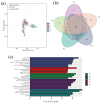Dynamic Response Mechanisms of Anammox Reactors Under Nitrogen-Loading Fluctuations: Nitrogen Removal Performance, Microbial Community Succession, and Metabolic Functions
- PMID: 40284735
- PMCID: PMC12029708
- DOI: 10.3390/microorganisms13040899
Dynamic Response Mechanisms of Anammox Reactors Under Nitrogen-Loading Fluctuations: Nitrogen Removal Performance, Microbial Community Succession, and Metabolic Functions
Abstract
The leachate from ion-adsorbed rare earth tailings poses challenges to the application of the anaerobic ammonium oxidation (anammox) process in this field due to its large fluctuations in ammonia nitrogen concentration (50-300 mg/L) and high flow rate (4000-10,000 m3/d). This study investigated the effects of nitrogen-loading rate (NLR) regulation on denitrification performance through reactor operation and elucidated the mechanisms of NLR impacts on anammox processes via microbial community analysis and metabolic profiling. The results revealed a nonlinear relationship between nitrogen loading and system performance. As NLR increased, both denitrification efficiency and anammox bacterial abundance (rising from 5.85% in phase P1 to 11.43% in P3) showed synchronous enhancement. However, excessive nitrogen loading (>3.68 kg/m3·d) or nitrogen starvation led to performance deterioration and reduced anammox bacterial abundance. Microbial communities adopted modular collaboration to counteract loading stress, with modularity indices of 0.563 and 0.545 observed in the inhibition phase (P2) and starvation phase (P4), respectively. Zi-Pi plot analysis demonstrated a significant increase in inter-module connectivity, indicating reinforced interspecies interactions among microorganisms to resist nitrogen-loading fluctuations.
Keywords: anaerobic ammonia oxidation; co-occurrence network; metabolic pathways; microbial community structure; rare earth tailings; substrate fluctuations.
Conflict of interest statement
The authors declare no conflicts of interest.
Figures








Similar articles
-
Nitrogen removal performance and microbial community structure in the start-up and substrate inhibition stages of an anammox reactor.J Biosci Bioeng. 2018 Jul;126(1):88-95. doi: 10.1016/j.jbiosc.2018.02.004. Epub 2018 Mar 10. J Biosci Bioeng. 2018. PMID: 29534943
-
[Setup and Microbial Community Analysis of ANAMMOX System for Landfill Leachate Treatment Coupling Partial Nitrification-Denitrification Process].Huan Jing Ke Xue. 2019 Sep 8;40(9):4195-4201. doi: 10.13227/j.hjkx.201901247. Huan Jing Ke Xue. 2019. PMID: 31854885 Chinese.
-
[Start-up and Recovery Performance of ANAMMOX Reactors Under Long-term Starvation].Huan Jing Ke Xue. 2024 Jul 8;45(7):4074-4081. doi: 10.13227/j.hjkx.202307153. Huan Jing Ke Xue. 2024. PMID: 39022955 Chinese.
-
Influence of seasonal temperature change on autotrophic nitrogen removal for mature landfill leachate treatment with high-ammonia by partial nitrification-Anammox process.J Environ Sci (China). 2021 Apr;102:291-300. doi: 10.1016/j.jes.2020.09.031. Epub 2020 Oct 13. J Environ Sci (China). 2021. PMID: 33637255 Review.
-
Feasibility and interest of the anammox process as treatment alternative for anaerobic digester supernatants in manure processing--an overview.J Environ Manage. 2013 Dec 15;131:170-84. doi: 10.1016/j.jenvman.2013.09.021. Epub 2013 Oct 25. J Environ Manage. 2013. PMID: 24161806 Review.
References
-
- Yang X.J., Lin A., Li X.L., Wu Y., Zhou W., Chen Z. China’s ion-adsorption rare earth resources, mining consequences and preservation. Environ. Dev. 2013;8:131–136. doi: 10.1016/j.envdev.2013.03.006. - DOI
-
- He Z., Zhang Z., Yu J., Xu Z., Chi R. Process optimization of rare earth and aluminum leaching from weathered crust elution-deposited rare earth ore with compound ammonium salts. J. Rare Earths. 2016;34:413–419. doi: 10.1016/S1002-0721(16)60042-X. - DOI
LinkOut - more resources
Full Text Sources
Research Materials
Miscellaneous

